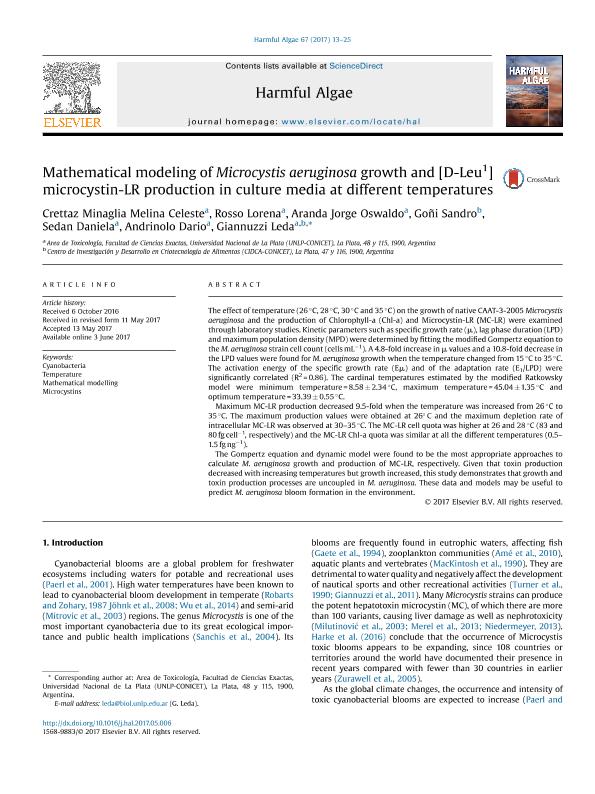Artículo
Mathematical modeling of Microcystis aeruginosa growth and [D-Leu1] microcystin-LR production in culture media at different temperatures
Crettaz Minaglia, Melina Celeste ; Rosso, Lorena Vanesa
; Rosso, Lorena Vanesa ; Aranda Mosquera, Jorge Oswaldo; Goñi, Sandro Mauricio
; Aranda Mosquera, Jorge Oswaldo; Goñi, Sandro Mauricio ; Sedan, Daniela Yazmine
; Sedan, Daniela Yazmine ; Andrinolo, Dario
; Andrinolo, Dario ; Giannuzzi, Leda
; Giannuzzi, Leda
 ; Rosso, Lorena Vanesa
; Rosso, Lorena Vanesa ; Aranda Mosquera, Jorge Oswaldo; Goñi, Sandro Mauricio
; Aranda Mosquera, Jorge Oswaldo; Goñi, Sandro Mauricio ; Sedan, Daniela Yazmine
; Sedan, Daniela Yazmine ; Andrinolo, Dario
; Andrinolo, Dario ; Giannuzzi, Leda
; Giannuzzi, Leda
Fecha de publicación:
07/2017
Editorial:
Elsevier Science
Revista:
Harmful Algae
ISSN:
1568-9883
Idioma:
Inglés
Tipo de recurso:
Artículo publicado
Clasificación temática:
Resumen
The effect of temperature (26 °C, 28 °C, 30 °C and 35 °C) on the growth of native CAAT-3-2005 Microcystis aeruginosa and the production of Chlorophyll-a (Chl-a) and Microcystin-LR (MC-LR) were examined through laboratory studies. Kinetic parameters such as specific growth rate (μ), lag phase duration (LPD) and maximum population density (MPD) were determined by fitting the modified Gompertz equation to the M. aeruginosa strain cell count (cells mL−1). A 4.8-fold increase in μ values and a 10.8-fold decrease in the LPD values were found for M. aeruginosa growth when the temperature changed from 15 °C to 35 °C. The activation energy of the specific growth rate (Eμ) and of the adaptation rate (E1/LPD) were significantly correlated (R2 = 0.86). The cardinal temperatures estimated by the modified Ratkowsky model were minimum temperature = 8.58 ± 2.34 °C, maximum temperature = 45.04 ± 1.35 °C and optimum temperature = 33.39 ± 0.55 °C. Maximum MC-LR production decreased 9.5-fold when the temperature was increased from 26 °C to 35 °C. The maximum production values were obtained at 26° C and the maximum depletion rate of intracellular MC-LR was observed at 30–35 °C. The MC-LR cell quota was higher at 26 and 28 °C (83 and 80 fg cell−1, respectively) and the MC-LR Chl-a quota was similar at all the different temperatures (0.5–1.5 fg ng−1). The Gompertz equation and dynamic model were found to be the most appropriate approaches to calculate M. aeruginosa growth and production of MC-LR, respectively. Given that toxin production decreased with increasing temperatures but growth increased, this study demonstrates that growth and toxin production processes are uncoupled in M. aeruginosa. These data and models may be useful to predict M. aeruginosa bloom formation in the environment.
Palabras clave:
CYANOBACTERIA
,
MATHEMATICAL MODELLING
,
MICROCYSTINS
,
TEMPERATURE
Archivos asociados
Licencia
Identificadores
Colecciones
Articulos(CCT - LA PLATA)
Articulos de CTRO.CIENTIFICO TECNOL.CONICET - LA PLATA
Articulos de CTRO.CIENTIFICO TECNOL.CONICET - LA PLATA
Citación
Crettaz Minaglia, Melina Celeste; Rosso, Lorena Vanesa; Aranda Mosquera, Jorge Oswaldo; Goñi, Sandro Mauricio; Sedan, Daniela Yazmine; et al.; Mathematical modeling of Microcystis aeruginosa growth and [D-Leu1] microcystin-LR production in culture media at different temperatures; Elsevier Science; Harmful Algae; 67; 7-2017; 13-25
Compartir
Altmétricas



